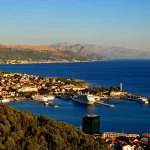January 16, 2020 – A new tourist tax will be paid by cruise ships from January next year, but will Split be making the most of it? A closer look.
Slobodna Dalamacija reports that in just one year, from January 1, 2021, cruisers moored in the port or anchored in the Split area will pay tourist taxes. The Tourist Tax Act, which was passed last year, stipulates that cities and municipalities may, but may not, charge tourist fees for international cruise ships at their ports or anchorages if so decided by the City or Municipal Council.
Fees are charged according to the number of passengers, that is, the capacity of the ship, and the Law stipulates that the minimum fee for ships up to 200 passengers is HRK 2000, while the maximum fee for ships carrying 3000 or more passengers is HRK 40,000. The city or municipality receives 85 percent of that money, and the County 15 percent.
The public consultation, which ended on December 31, 2019, featured a “Draft Proposal for a Decision on the Tourist Fee Amount for Cruise Ships”. It proposes that the minimum price be HRK 1,000 and the maximum price HRK 20,000. The City of Split has decided to collect an amount two times less than the law allows.
We must add that the funds collected under the Act are intended to be earmarked for improving public and tourist infrastructure and for projects and programs for sustainable development. In other words, the City of Split gave up half of the money it could have used to improve communal infrastructure, arranging beaches, lighting, bench repairs, horticulture, and so on.
On the other hand, Dubrovnik has decided to charge the maximum amount from 2021. They expect revenues of HRK 10-14 million per year.
Zadar, for example, decided that for the Gaženica port, which is a large infrastructure project made with state money, they would continue to charge nothing to cruisers in order to increase their competitiveness, but also divert cruisers to a location outside the crowded city center. For this reason, cruisers who want to anchor in the city center, next to the ‘Monument to the Sun’ and the ‘Sea Organ’, will be charged the maximum because it is an attractive location.
However, for a spot at the Split city port, right next to the famous Riva and the world-famous Diocletian’s Palace, cruise ships are getting a considerable discount.
The initiative to collect fees began in Dubrovnik, which is overrun by cruise ships in the summer.
The power ratio is roughly such that the people of Dubrovnik have more cruisers than Split and Zadar combined. That is, twice as many cruisers come to Dubrovnik annually than to Split, which in turn has twice as many ships as Zadar.
Translated from Slobodna Dalamacija
To read more about travel in Croatia, follow TCN’s dedicated page.










